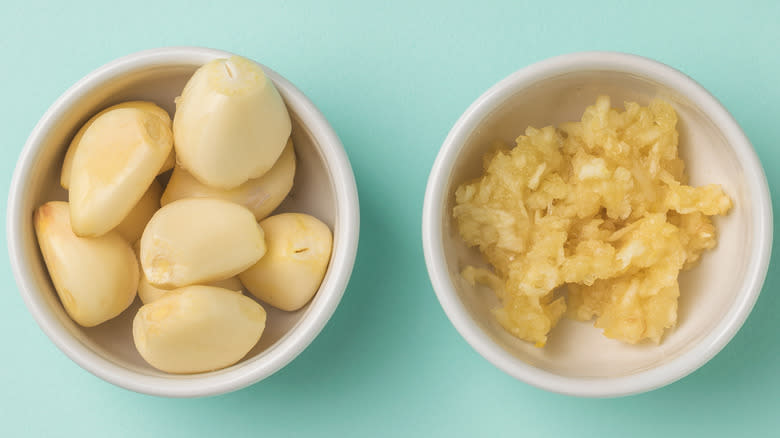How To Get The Most, Or The Least, Flavor Out Of Fresh Garlic

Whether it's an Asian stir fry, an Italian pasta, a Middle Eastern stew, or a zesty bowl of guacamole, culinary traditions around the globe all utilize the aromatic and transformative powers of garlic. This universal ingredient can be spicy and pungent, rich and sweet, or earthy and savory depending on whether you use it raw, roast it, or saute it. Furthermore, you can maximize or minimize the strength of garlic's flavor through the way you prepare it.
Garlic's inimitable smell, flavor, and antibiotic properties are all the result of a chemical compound called allicin that gets released when you cut, smash, or otherwise damage an intact clove. Larger amounts of allicin are released as garlic is broken down more and more, allowing you to manipulate its strength as a flavoring agent.
If you want to minimize garlic's flavor in a recipe, you'll only slightly break down its cloves with minimal chops. For the strongest garlic flavor, you'll want to break down each clove as much as possible by thinly shredding it through a microplane or the smallest holes of a box grater. To split the difference, a garlic press will give you a good mid-range texture and flavor that is stronger than a rough chop but weaker than a pasty grate. Whether you're using garlic raw for a kick of spice or cooked for an earthier, sweeter, aromatic palate, you can control its flavor output with a knife, press, or grater.
Read more: 15 Best Knife Brands, Ranked
More Garlic Tips

While many of us are of the belief that there's no such thing as too much garlic, many dishes use garlic as a subtle flavor enhancement that complements the main ingredients instead of overpowering them. Plus, it only takes a clove or two to infuse a dish with flavor, especially if you know how to break it down. Guacamole, slow-cooked stews, braised meats, curries, and marinara sauce all benefit from the subtleties of roughly chopped garlic. A slower, lower-cooked dish allows the garlic to gently infuse its flavor over time.
Use grated garlic in dishes where you want garlic to be the star of the show or when used in conjunction with other bold flavors. Grated garlic intensifies the flavor and aroma of garlic-centric recipes like garlic butter, garlic bread, and garlic sauces. Asian stir-fries and sauces often call for grated or finely minced garlic and ginger fried together for an extra strong aromatic burst to pair with equally intense liquids and pastes like soy sauce, miso, peanut butter, or fish sauce.
Another way to temper garlic's potency is by letting chopped or grated garlic sit in an acid like vinegar or lemon juice. Even in a garlic-forward dish, blending lemon juice with grated garlic will still give you an intense garlic flavor without too harsh of an afterbite. You'll often see this trick applied in vinaigrettes and other garlic-infused salad dressings.
Read the original article on Tasting Table.